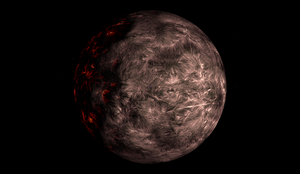61 Virginis b
| Exoplanet | List of exoplanets | |
|---|---|---|
 | ||
| Parent star | ||
| Star | 61 Virginis | |
| Constellation | Virgo | |
| Right ascension | (α) | 13h 18m 24.3s |
| Declination | (δ) | −18° 18′ 40.3″ |
| Apparent magnitude | (mV) | 4.74 |
| Distance | 27.8±0.2 ly (8.52±0.05 pc) | |
| Spectral type | G5V | |
| Mass | (m) | 0.942+0.034 −0.029 M☉ |
| Radius | (r) | 0.98 (± 0.03) R☉ |
| Temperature | (T) | 5531 K |
| Metallicity | [Fe/H] | −0.02 |
| Age | 8.96+2.76 −3.08 Gyr | |
| Physical characteristics | ||
| Minimum mass | (m sin i) | 5.1 (± 0.5)[1] M⊕ |
| Radius | (r) | ~1.6 R⊕ |
| Stellar flux | (F⊙) | 296.5[2] ⊕ |
| Temperature | (T) | 1,054 K (781 °C; 1,438 °F) |
| Orbital elements | ||
| Semi-major axis | (a) | 0.050201±0.000005 AU (7.5100 Gm) |
| Periastron | (q) | 0.044239 AU (6.6181 Gm) |
| Apastron | (Q) | 0.056163 AU (8.4019 Gm) |
| Eccentricity | (e) | 0.12±0.11 |
| Orbital period | (P) | 4.2150±0.0006 d |
| (101.16 h) | ||
| Orbital speed | (υ) | 130.01 km/s |
| Argument of periastron |
(ω) | 105±54° |
| Time of periastron | (T0) | 2453369.166 JD |
| Discovery information | ||
| Discovery date | 14 December 2009 | |
| Discoverer(s) | Vogt et al. | |
| Discovery method | Radial velocity | |
| Discovery site | Keck Observatory Anglo-Australian Observatory | |
| Discovery status | Confirmed[3] | |
| Database references | ||
| Extrasolar Planets Encyclopaedia | data | |
| SIMBAD | data | |
| Exoplanet Archive | data | |
| Open Exoplanet Catalogue | data | |
61 Virginis b (abbreviated 61 Vir b) is an extrasolar planet, orbiting the 5th magnitude G-type star 61 Virginis, in Virgo. This planet has a minimum mass of 5.1 times that of Earth and is an example of a super-Earth planet. It orbits very close to the star, at a distance of 0.050201 AU with an eccentricity of 0.12. This planet was discovered on 14 December 2009 using the radial velocity method taken at Keck and Anglo-Australian Observatories.[1][4]
Characteristics
Mass, radius and temperature
61 Virginis b is a super-Earth, an exoplanet with a radius and mass bigger than Earth, but smaller than that of the ice giants Neptune and Uranus. It has an equilibrium temperature of 1,054 K (781 °C; 1,438 °F).[2] It has an estimated minimum mass of around 5.1 M⊕, and a potential radius of 1.6 R⊕, based on its mass.
Host star
The planet orbits a (G-type) star named 61 Virginis, orbited by a total of three planets.[1] The star has a mass of 0.94 M☉ and a radius of 0.98 R☉. It has a temperature of 5531 K and is about 8.96 billion years old.[1] In comparison, the Sun is 4.6 billion years old[5] and has a temperature of 5778 K.[6] The star has slightly less metals then the Sun, with a metallicity ([Fe/H]) of −0.03, or 94% of the solar amount.[1] Its luminosity (L☉) is 80% that of the Sun.[1]
The star's apparent magnitude, or how bright it appears from Earth's perspective, is 4.74. Therefore, it can be seen with the naked eye.
Orbit
61 Virginis b orbits its host star with an orbital period of 4.21 days at a distance of about 0.05 AU (compared to Mercury's from the Sun, which is 0.38 AU). It receives 296.5 times more sunlight that Earth does from the Sun.[2]
Discovery
The search for 61 Virginis b started when its host star was chosen an ideal target for a planet search using the radial velocity method (in which the gravitational pull of a planet on its star is measured by observing the resulting Doppler shift), as stellar activity would not overly mask or mimic Doppler spectroscopy measurements. It was also confirmed that 61 Virginis is neither a binary star nor a quickly rotating star, common false positives when searching for transiting planets.
Analysis of the resulting data found that the radial velocity variations most likely indicated the existence of a planet.[1] The net result was an estimate of a 5.1 M⊕ planetary companion orbiting the star at a distance of 0.05 AU with an eccentricity of 0.12.
See also
References
- 1 2 3 4 5 6 7 Vogt, Steven (2009). "A Super-Earth and two Neptunes Orbiting the Nearby Sun-like star 61 Virginis". arXiv:0912.2599v1
 [astro-ph.EP].
[astro-ph.EP]. - 1 2 3 http://www.hpcf.upr.edu/~abel/phl/hec_plots/hec_orbit/hec_orbit_61_Vir_b.png
- ↑ M. C. Wyatt; et al. (2012). "Herschel imaging of 61 Vir: implications for the prevalence of debris in low-mass planetary systems". MNRAS. arXiv:1206.2370
 . Bibcode:2012MNRAS.424.1206W. doi:10.1111/j.1365-2966.2012.21298.x.
. Bibcode:2012MNRAS.424.1206W. doi:10.1111/j.1365-2966.2012.21298.x. - ↑ Tim Stephens (2009-12-14). "New planet discoveries suggest low-mass planets are common around nearby stars". UCSC News. UC Santa Cruz. Archived from the original on 23 December 2009. Retrieved 2009-12-14.
- ↑ Fraser Cain (16 September 2008). "How Old is the Sun?". Universe Today. Retrieved 19 February 2011.
- ↑ Fraser Cain (15 September 2008). "Temperature of the Sun". Universe Today. Retrieved 19 February 2011.
External links
- Jean Schneider (2011). "Notes for Planet 61 Vir b". Extrasolar Planets Encyclopaedia. Retrieved 10 October 2011.
Coordinates: ![]() 13h 18m 24.3s, −18° 18′ 40.3″
13h 18m 24.3s, −18° 18′ 40.3″